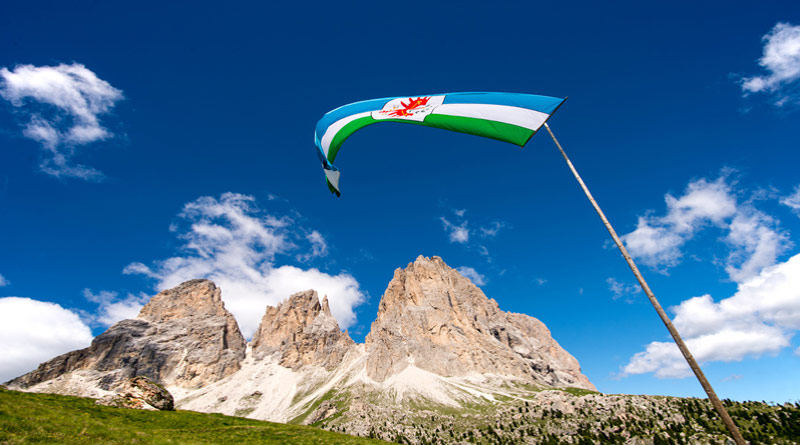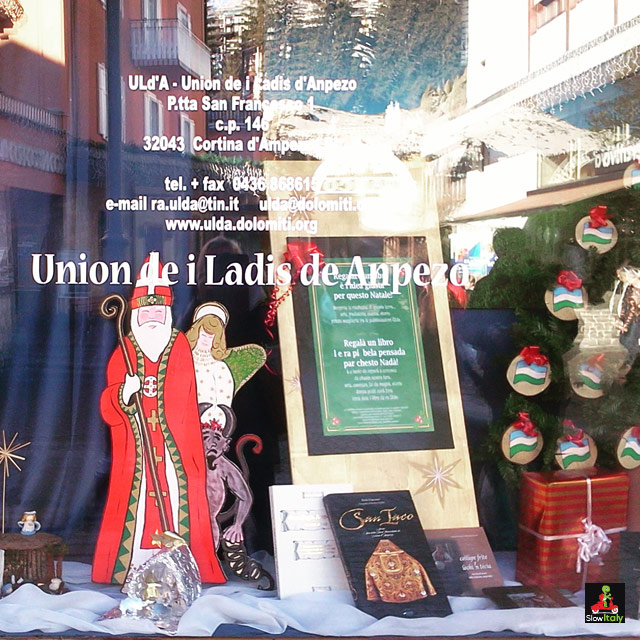
Definition and significance
Ladin is the language spoken by the Ladins in the Dolomite Mountains of Northern Italy. It is part of the Rhaeto-Romance languages, a group to which also Romansch and Friulian belong. Romansch is spoken in the Upper Rhine valley and the Inn, and is one of the official languages of Switzerland, while Friulian is the local language of the Italian autonomous region of Friuli-Venezia Giulia.
It should not be confused with Ladino, the Spanish-like language spoken by descendants of the Jews who were exiled from Spain and Portugal at the end of the 15th century. The latter is also known as Judezmo or Judaeo-Spanish. Note that in its own language and in Italian, Ladin is called Ladino, while the diaspora language is usually referred to as giudeo-spagnolo, judezmo o giudezmo.
Regional languages like the Ladin language of the Dolomites are particularly interesting from a linguistic point of view, because they are often much older than the dominant languages and have often kept relics of the linguistic substratum that was present before the arrival of successive invaders. Due to the isolation of its speakers in extremely mountainous regions, the Ladin language has managed to survive despite pressures from surrounding languages.

History and Linguistic genealogy
Ladin is an independent language group with its own phonetic and morphological characteristics which individualizes it among the neighboring languages. It is by no means a dialect of Italian, despite what some people like to think. It forms a language of its own, just like Sardinian, for example, not only from a lexical, but also from a grammatical, etymological and phonological point of view. It was recognized as such by many linguists (first of all Graziadio Isaia Ascoli in 1800) and by a resolution of the European Union, which promoted a number of initiatives in order to defend the linguistic minorities.
Ladin is considered a neo-Latin language, i.e. a language that, just like French, Provençal, Catalan, Italian and Spanish, etc. derived from a Latin dialect, a vulgarized form of Latin. The vulgarized forms of Latin were mainly spoken by soldiers and merchants, precisely those Romans who traveled to the outposts of the Roman Empire, where the different Latin dialects slowly evolved into new languages, the so-called neo-Latin or Romance languages, due to geographic, historical and social influences.
The neo-latin languages, going from west to east include the:
1. Portoguese languages
2. Spanish languages
3. Catalan languages
4. Provincial languages
5. Franco-provincial languages
6. French languages
7. Sardian languages
8. Ladin languages
9. High-Italian languages
10. Italian languages
11. Dalmatian languages
12. Romenian languages
Like all Romance language which derived from a vulgarized form of Latin, Ladin evolved into an independent language. Most linguists agree in saying that the Ladin or Rhaeto-Romance languages have formed a unified linguistic system since Antiquity, distinct from high-Italian, that was spoken with sufficient homogeneity on the Alps from San Gottardo to Istria (including the Alto Adige and all of Cadore) and in the friulian and danubian plains, until it was dismantled into three fragments.
At the time of the germanic invasions from 450 to 570 ca, when the Alemannics and the Baiuvarians went south, then the progression of the Lombards northwards and the Slavic population towards the East from 600 on, the Ladin linguistic area contracted, due to the fact that the population was partially assimilated by the invaders. By 1150 ca. South-Tyrol was for three quarters Germanized. The contiguity between the Ladins of the Dolomites and the retro-Romantic area of the west was soon interrupted. In the XV century, the Republic of Venice conquered Friuli and Cadore. Since then the linguistic wedge of the Veneto region has penetrated more and more deeply along the valley of the Piave, ending up with the separation of the Ladins of the Dolomites and those of Fruili.
According to the language historian Giuseppe Richebuono, the uniqueness of the Ladin language is precisely due to the fact that it was influenced by a vulgarized form of Latin of a different origin (Aquileia), added to the linguistic substratum that was already present before the celticization. Centuries of geographical isolation and influence of the confining languages, German to the North and Italian to the South, did the rest. Around 400 BC the western part of Northern Italy was inhabited by Ligurians, the central part by Etruscans, the Eastern part by Venetic, while the central Alps were inhabited by the Rhaeti and Illyrians. The Rhaetic language is poorly documented, but was probably present from the fifth to first centuries BC. Rhaetic and Etruscan belong to the same language family and are so closely related that they were probably mutually understandable. Their common source language was Proto-Tyrsenic.
Varieties of Ladin
The Ladin of the Dolomites can be divided into five varieties:
- Fascian in the Fassa Valley, with mainly italian influences,
- Ghërdeina (gardenese) in the Gardena Valley, closer to German,
- Badiot in the Badia Valley, a little less “germanized” than Ghërdeina and considered by some the ‘purest’ form of Ladin,
- Fodom in Livinallongo,
- Ampezan in Cortina, with influences of Venetian.
Ladin today
At present, the Ladins of the Dolomites are politically and administratively separated into three provinces (Bolzano, Trento, and Belluno) and two regions (Trentino Alto Adige and Veneto).
In order to guarantee the survival and the development of the Ladin language and culture in the future, the Ladin community strives to obtain official recognition of the Ladin community as a whole and work towards an increased use of the language in all the expressions of social life and the promotion of Ladin culture and tradition.
A Standard written variety of Ladin (Ladin Dolomitan) has been developed by the Office for Ladin Language Planning as a common communication tool across the whole Ladin-speaking region.
Ladin literature is relatively young; in fact, the first documents date back to the year 1700. Ladins have also their own weekly newspaper, called “La Usc di Ladins”, and their radio and television broadcasts, thanks to the ladin RAI in Bolzano. Ladin is taught in primary and secondary schools in Val Gardena and in high schools, as well in Val Badia.
See also:
Regional languages of Italy
Extinct and dead languages of Italy
Minority languages of Italy
Italian loanwords in English

